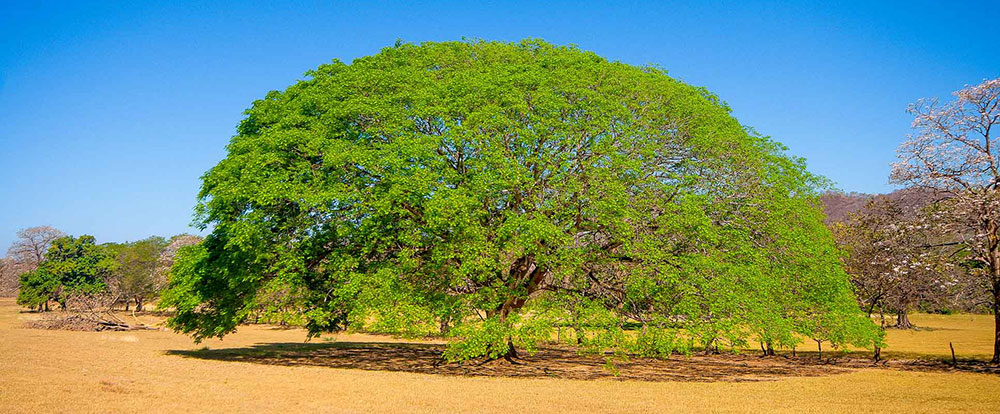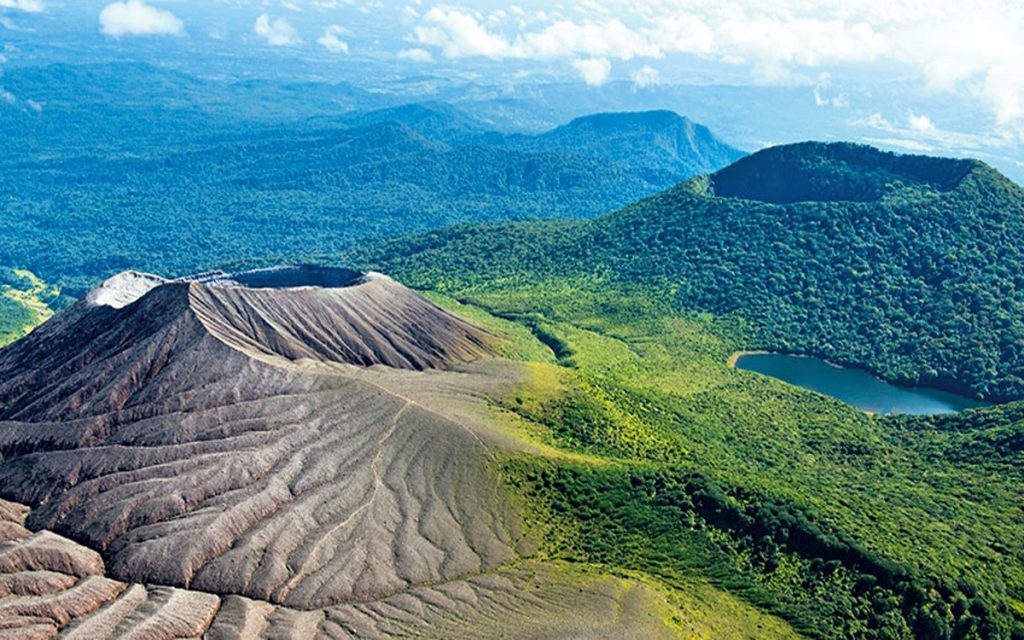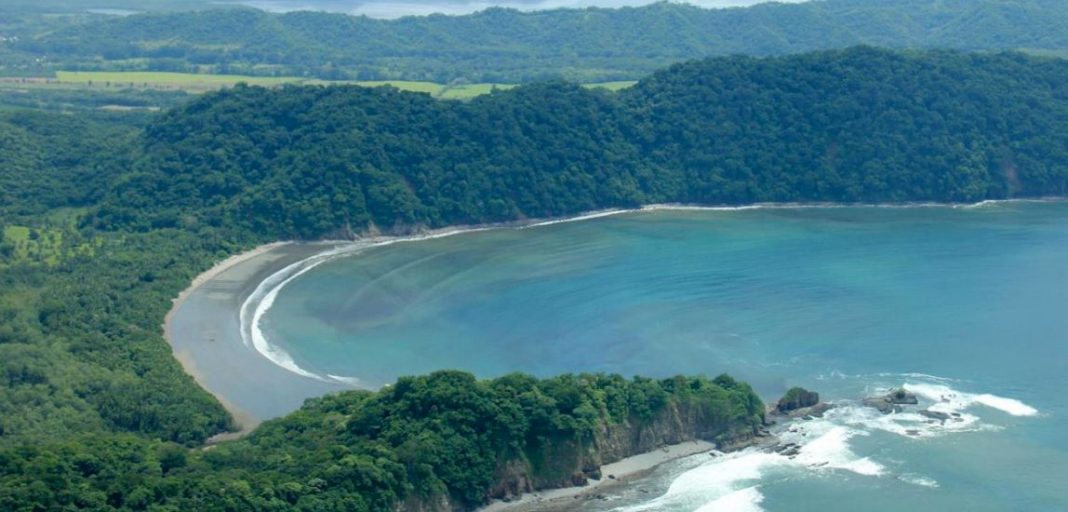Adapted from Evelio’s Garden: Memoir of a Naturalist in Costa Rica
The upper reaches of the Inter-American Highway are nothing more than a country back road, one lane in each direction, lined with heavy old trees and second-growth forest and offering spectacular vistas, from its pass through the mountains, of the Guanacaste Plain, the Gulf of Nicoya and the blue-gray mountains that divide the peninsula from the Pacific. For decades, the only trucking route northwest from San José to the ports of Caldera and Puntarenas or the border with Nicaragua, this pass has always been a driving nightmare. One is frequently caught in long “elephant trains” of eighteen-wheelers belching smoke and grinding their way up or down the mountain in their lowest gears. Heading north, once past the exit for Caldera, however, the road is seldom congested except for the occasional road accident or bridge washed out. I frequently marvel, as I’m taking this route, that it is the same route that – except for a gap between Panama and Colombia that has to be end-run by a ferry – stretches from Tierra del Fuego all the way to Alaska, in most places in far better repair than it is here in Costa Rica. Just across the border in Nicaragua, it turns into a beautiful four-lane highway, well-marked, well-maintained. The reason, I suspect, lies in the presence of a military. I am reminded that President Eisenhower prioritized the U.S. Interstate highway system for public defense after World War II. Costa Rica has no army, so it becomes a matter of reverse pride that our roads are so bad.
But back to the trees. Stretching over the roadway on the Interamericana Norte are hundreds of guanacaste trees, their broad branches heavy with termite nests and epiphytes which, in the hot lowlands, tend to be succulents, as opposed to the bromeliads and air plants on the trees around Lake Arenal. Many of these old trees are huge, obvious remnants of the days when this road was first carved through virgin forest in the fifties. In the indigenous language of northwestern Costa Rica, guanacaste means “tree of the ear,” so called because of its large, flat, roundish, dark-brown seedpods. The seeds themselves, difficult to pry out of the tough white flesh inside the pods, are polished black and brown ovals, so beautiful and durable that they were once used as a means of exchange. Like others in the mimosa family, guanacastes are fast growers with lovely lacy foliage and wispy pink blooms, and their giant domed canopies make for welcome shade throughout northern Costa Rica, especially along the highway in what remains of the ancient dry tropical forest.

Lacking a car for some years, I quickly learned to adapt to the discomforts and courtesies of long-distance bus travel in Costa Rica. First was to find a seat by a window that opened. Many older rural Costa Ricans don’t like air blowing on them; they think it makes them sick. So, no matter what the ambient temperature, the un-air-conditioned buses barreled down the road through the lowlands like hermetically sealed infernos. The only exception to this was when a young woman in the seat across the aisle from me threw up her breakfast just after we took off from Tilarán. I prayed she would get off in Cañas, but no, she sat there, too embarrassed to move, her morning’s rice and beans in her lap for four and a half hours. On that trip, all the windows flew open and stayed that way.
Second, I quickly learned not to sit behind the driver on a night run. These guys are cowboys, the headlights reach only so far, there are frequently no lines painted on the road, it’s dark as pitch out there and it feels as if we’re flying completely blind. Not for the faint of heart.
Third, drink little and empty your bladder fully before boarding the bus. It didn’t always make a rest stop. One time the bus driver pulled over to the side and yelled back that the gentleman who wanted to go to the bathroom could do so now, and a voice from the rear hollered, “That’s all right. Never mind!” There was general laughter on board, the driver shrugged in that exaggerated Latin way and pulled back into traffic.
In daylight I would try to read, but there was constant social chatter, crying babies and mariachis playing loudly on the radio. I remember one moment, crossing that mountaintop just at sundown, the magnificent Costa Rican scenery stretching out all around me in the waning light, the mariachis singing, a general feeling of contentment and goodwill on the bus as we all swerved back and forth around the hairpin curves, being overcome by happiness to find myself winding serenely along a Central American highway. It was a “what am I doing here?” moment, and the answer was that I was going home.
Arrival, no matter how long I’ve been away, is always a balm to the spirit. When I turn the corner off the Interamericana at the bullring and drive through the town of Cañas – which takes only a minute – I breathe a sigh of relief to be finally on a real back road without the pressure of international traffic. The elevation at Cañas is only 210 feet above sea-level, and you steadily rise another 1500 feet in just fourteen miles, through wide, windy vistas of pastureland and stranded, stunted trees, the rank of volcanoes Tenorio, Miravalles, and Rincón de la Vieja marching northwest off to your left. In the last few miles before Tilarán, the view closes in and you negotiate a series of hairpin curves, zip through the farming village of Los Angeles, and dip up, down and around as you skim the billowing waves of the Tilarán Mountains. On one curve stand three giant ceiba trees that always lift the heart. Farther on is a glimpse of Tilarán itself, off to the right, huddled on a small raft in an ocean of green. Just before the last rise, you cross a little bridge in a jungle glade that gives you one last reminder that civilization in these parts is still a relatively recent thing.

The first time ever I crested the last hill, the long view of the blue bowl of the lake amid its lushly green hills took my breath away. All these many years later, it still gladdens my heart.

